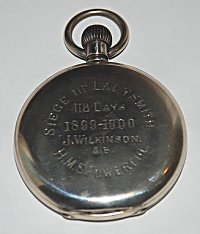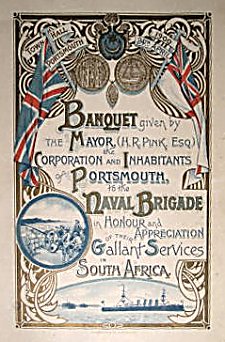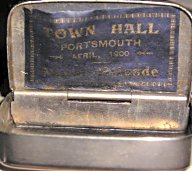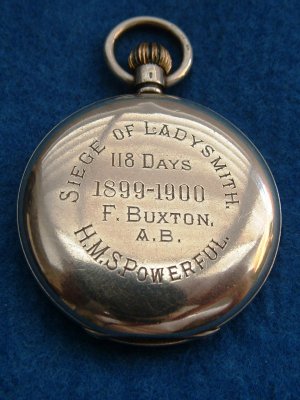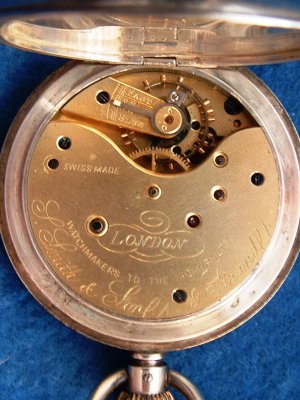Location
On the main walk through Victoria Park.
Description
Pink granite plinth on cement base. Truncated pyramidal base, column surmounting. Base 1.5m square.
Memorial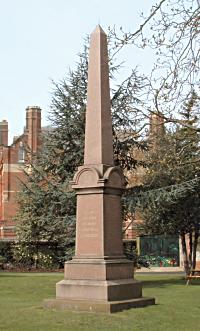 HMS Powerful
HMS Powerful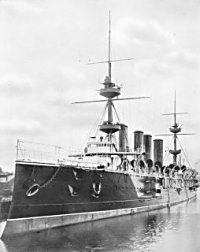
SPECIFICATIONS
Displacement - 14,200tons
Dimensions - 538x71x27ft
Machinery - 2-shaft, 4 cyl TE, 48 Belleville boilers, 25,000ihp. Coal 3000t
Armour - Deck 6in-2in, barbettes, turrets 6in, ammunition hoists 2in, casemates 6in-2in, CT 12in
Armament - 2-9.2in, 12-6in QF, 16-12pdr QF, 12-3pdr QF, 4-18in TT sub
Complement - 894
Launched - 8.6.1897
Builder - Vickers, Barrow
Fate - sold 1929
Kimberley Memorial - 1
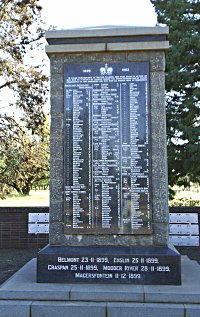 Kimberley - 1 (Detail)
Kimberley - 1 (Detail)
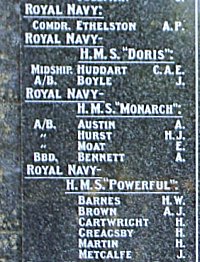 Kimberley - 2 (Detail)
Kimberley - 2 (Detail)
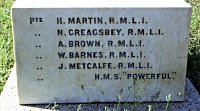 4.7in Gun
4.7in Gun

Inscription (Front)
SOUTH
AFRICA
1899-1900
Inscription (Left)
ERECTED
BY
CAPTAIN
THE HON.HEDWORTH LAMBTON C.C.
OFFICERS
AND SHIP'S COMPANY
OF HMS POWERFUL
Inscription (Back)
TO THE MEMORY OF
THE OFFICERS AND MEN OF THE
NAVAL BRIGADES OF H.M.S.POWERFUL
WHO WERE KILLED IN ACTION OR DIED
DURING THE CAMPAIGN
IN SOUTH AFRICA 1899-1900.
Commander ALFRED P.ETHELSTON RN
Commander FREDERICK C.EGERTON RN
Fleet Paymaster WILLIAM H.F.KAY RN
Lieutenant EDWARD STABB RNR
|
A.FINNIMORE PO1stCl
W.W.TRUESDELL
F.G.TRIGGS
T.HANNIFIN PO1stCl.
G.KNOTT
W.A.WOLFE
J.S.WHITE Arm. Mate
W.TRIBE Lg.Sea
E.J.CAULTER
B.BLUMSON A.B.
A.G.PAYNE
H.A.LISTER
R.HARRIS
E.F.DUNN
H.E.BLAKE
B.NEWELL
A.W.BENTON
G.JOHN
J.STEWART
C.BOYCE
A.MUSGROVE
F.JOHNSON Arm. Crew
|
G.SEARES Stoker
J.LEATHER
D.PATON
H.W.C.GARDENER
A.P.ROLLS
E.A.ARCHER Ord
D.J.WHEELER
C.H.ARSCOTT
H.TREVETT
C.E.MINSHAW
A.CALDWELL
H.W.PANNIFER
E.E.DEXTER
A.I.BROWN Pvt RMLI
J.METCALFE
H.MARTIN
H.T.CARTWRIGHT
W.H.BARNES
H.GREAGSBEY
H.NEWMAN
J.DONALDSON
|
LADYSMITH
GRASPAN
BELMONT
MODDER RIVER
PAAEDEBERG
THE POWERFUL NAVAL BRIGADE IN THE SOUTH AFRICAN WAR
In the Autumn of 1899 HMS Powerful was on her way home after being stationed for three years in China when she was diverted to South Africa as the war against the Boers hotted up. She originally docked at Simonstown where members of the crew practised drill and gunnery practice. On 20th October 300 Marines were landed further up the coast with orders to defend Stormberg. They were commanded by Commander Ethelston of HMS Powerful and Major Lumbe (RMLI) of HMS Doris. For some weeks they saw little action but by 25th November had moved up country where they faced the Boer at Graspan along with army regiments under the command of Lord Methuen. This was one of the first times that British forces had marched against an enemy equipped with modern German Mausers and within a very short time over half the Naval Brigade was dead or injured. They played little or no part in further action, but they had lost both Ethelston and Lumbe.
Even before the battle of Graspan had occurred a separate brigade from HMS Powerful landed at Durban on 27th October with a battery of heavy guns including their famous 4.7s. They made their way towards Ladysmith where the Powerful's Captain Lambton controlled Naval operations during the relief of the town; the 4.7s having an important impact on the outcome.
For an account of how the guns were dispatched to Ladysmith see "50 Years in the Royal Navy" by Admiral Sir Percy Scott. Further information about the South African War can be found in "Ladysmith, The Diary of a Siege" by H.W. Nevinson.
POWERFUL - THE SALT OF THE EARTH AND SEA.
"In 1895, HMS Powerful, a first-class cruiser, was launched. She was destined to make a reputation of great importance, for it was due to the timely appearance of a Naval Brigade from the vessel, armed with two 4.7in. guns and four 12 pounders, that Ladysmith was saved at the outbreak of the Boer war. All through the siege the bluejackets contributed most cheerfully in its defence, taking their privations with a smile and displaying such courage and devotion as won universal admiration.
Mr. G. W. Steevens, a talented correspondent, who died before the relief came, having paid a visit to the Naval Battery, and seen the men work their well-beloved guns, he wrote an account of it in his own inimitable style, and wound up with the following panegyric: -
"This handful of sailors have been the saving of Ladysmith. You don't know, till you have tried it, what a worm you feel when the enemy is plugging shell into you, and you can't possibly plug back. Even though they spared their shell, it made all the world of difference to know that the sailors could reach the big guns if they ever became unbearable. It makes all the difference to the Boers too, I suspect; for as sure as Lady Ann or Bloody Mary gets on to them, they shut up in a round or two. To have the very men among you makes the difference between rain-water and brine.
The other day they sent a 12-pounder up to Caesar's Camp under a boy who, if he were not commanding big men round a big gun in a big war, might with luck be in the Fifth Form. 'There's a 94-pounder up there,' said a high officer, who might just have been his grandfather. 'All right, sir,' said the child, serenely, 'we'll knock him out.'
He hasn't knocked him out yet, but he is going to next shot, which in a siege is the next best thing. In the meantime he has had his gun's name 'Lady Ellen' neatly carved on a stone and put up on his emplacement. Another gun-pit bears the golden legend 'Princess Victoria Battery,' on a board elegant beyond the dreams of suburban preparatory schools. A regiment would have had no paint or gold-leaf; the sailors always have everything.
'They carry their home with them, self-subsisting, self-relying. Even as the constant blue-jacket says, "Eight Gun Hill up, sir" there floats from below ting-ting, ting-ting, ting.'
Five bells."
A full version of Steevens' report can be found at the Gutenburg Project
The development of the Naval Field Gun Run at the Royal Tournament started from the appearance in 1900 of a crew from HMS Powerful that had served in South Africa. This developed into the first competition in 1907.
The Return of HMS Powerful to Portsmouth
By the time HMS Powerful returned to Portsmouth on 11th April 1900, after the action at Ladysmith, her exploits were common knowledge in England. The men of the ship and particularly the Naval Brigade were regarded as heroes and the people of Portsmouth were determined to celebrate their return. A correspondent from the Daily News reported the arrival as follows:-
![HMS Powerful returns home [Photograph taken by William Martin]](images/powerful-home.gif) HMS Powerful arriving in Portsmouth
HMS Powerful arriving in Portsmouth"It has been a memorable day. HMS Powerful has arrived in Portsmouth, and the lads of the Naval Brigade have met with a reception they will never forget......There was to have been a great prepared ovation, with a march through decorated streets and a banquet at the Town Hall, but the Municipal and Admiralty authorities could not agree on such a programme for today. So the formal glorification stands postponed till April 24th, but the public has insisted on celebrating the home-coming of the heroes.
"
As the great vessel steamed into Portsmouth Harbour at four o'clock this afternoon, she was greeted with thunders of applause from the two shores, which were black with people. The Victory, the St. Vincent, the Hero, the Trafalgar, and other vessels lying off here were dressed with flags, and their crews, swarming along the yards, swelled the roar of welcome...... the premises of Messrs E and E Emanuel afford as beautiful a display of emblematic decorations as could well be conceived. Other buildings have also been made beautiful with bunting; but such outward and visible signs of the public pride and delight are comparitively few, and the reason for this is not, as has been ingeniously suggested - that a famine in flags has resulted from the heavy Irish demand. The feeling among the townsfolk is that street decorations should be held in reserve for the demonstration of the 24th.
"
By three o'clock the jetty was thronged with men, women and children. These were the relatives of the crew of the expected Powerful. The corduroyed father of a cabin boy rubbed shoulders with the frock-coated brother of an officer. A more eager, joyous gathering I never saw. Fine rain fell but no one minded that.....
"
The Commander-in-Chief and his party did not reach the jetty till half past three. Beside the First Lord of the Admmiralty, there came with Sir Michael (Culme-Seymour), Lord Durham (brother of the vessel's commander, Captain Lambton), Lord George Hamilton, Lord Claud Hamilton, Lord Farquhar, the Earl and Countess of Pembroke, Lady Tryon, Lady Anne Lambton, Lady Chelsea, Lady Wolverton, Lord and Lady Robert Cecil, Lady Alwyne Compton and Miss Agnes Weston.
"
We heard the murmur of distant cheers before we saw the ship. Anon naval eyes discerning her moving masts, and then the great, black hull with funnels and deck fittings painted buff, glided into view. Bluejackets swarmed along the decks, and little faces peered from the portholes. We cheered, we waved hats and handkerchiefs and we were half wild with delight.
"
The Banquet in Honour of the Crew of HMS Powerful
On 24th April 1900 the people of Portsmouth invited the crew of HMS Powerful to a banquet at the Town Hall (now Guildhall).
![The Crew of HMS Powerful March to the Town Hall [Photograph: Lankester, Tunbridge Wells, copied from the Navy and Army Illustrated]](images/powerful-guildhall.gif)
The Naval Brigade enter the Town Hall |
![The Banquet at the Town Hall [Photograph: A. Debenham, Ryde, copied from the Navy and Army Illustrated]](images/powerful-banquet.gif)
The HMS Powerful Banquet |
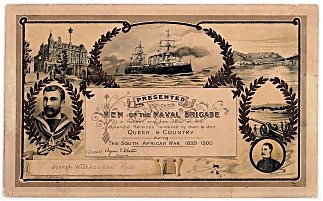
A Certificate presented to each man by Agnes Weston |
At the dinner the Mayor presented a silver watch to each member of the crew, reportedly a gift from members of the Naval and Military Club, Piccadilly. The watches were engraved with the words "Seige of Ladysmith 118 days 1899-1900" followed by the name of the recipient and "HMS Powerful". Later the men were also presented by Lloyds, a round silver tobacco tin with a crest portraying the flag of St. George and a ships anchor engraved on the lid.
The information concerning the presentation of watches is believed to have originated in the Daily Telegraph of 29th March 1900 but thanks to research by Marion Quillan there is good reason to doubt the story, at least inasmuch as the Naval and Military Club is concerned. The Librarian at the club located minutes from 3 meetings in 1900 in which the Secretary of the Naval and Military Club was instructed to write to the Editor (of the Daily Telegraph) requesting that he contradict the story on the grounds that it had no foundation. The origin of the watches remains unconfirmed but it seems likely that they were paid for and presented by the Admiralty given that they were made by S. Smith & Son, 7 The Strand, Makers to the Admiralty.
In March 2012 Stephen Robertson wrote to say that he had contacted Lloyds to see if they had donated the watches and received the following information:- "Lloyds entertained the men to lunch in the Old Reading Room in the Royal Exchange. Lloyd's was of course closed for the day. The men arrived about noon with their guns, and the string band of the Royal Artillery played in the
quadrangle of the Royal Exchange. Tabies were laid the whole length of the Room, tastefully decorated with flowers, and the men sat down to a gargantuan feast. The waiters were the Members of Lloyd's, and I was one with others engaged in drawing beer as fast as we could to quench the men's everlasting thirst. After the meal, the sailors were presented with silver boxes filled with tobacco. It certainly was a wonderful and memorable day". Steve also obtained extracts from a Lloyds Log from 1953 which contained a lengthy description of the events on May 7th 1900. Read it here.
In October 2007 we received our first photograph of one of the watches (see article below on HJ Keirl) and the inscription that appears on it. There is no mention of the Naval and Military Club nor indeed any information about the donor. Alongside the photo of the watch we also received a photo of a purse which is said to have held the tobacco tin, but no tin itself. A couple of months later we received a second photo of a watch (see article below on John Wilkinson) and this time it was accompanied by a Certificate of Warranty.
In September 2008 we finally received by e-mail a photograph of the tobacco tin (see article below on Albert Charles Brook). This was inscribed with the date of 7th May 1900 which, given the information from Lloyds, above, must have been the date of the feast. The photograph confirms that the flag of St. George and the anchor were indeed inscribed alongside the date.
In March 2009, Susan Randall (Great Grand-Daughter of Arthur Hickman - see article below) wrote to say that the significance of the date 7th May was that it was on this day that the men of the Naval Brigade were to be inspected by the First Lord of the Admiralty. This review took place on the same grounds where the Trooping of the Colours was held and attendance was much sought after with tickets for the event being sold to Members of Parliament. Lloyds commemorated this occasion with a feast and gift of the tobacco tins.
The Blue Jackets of HMS Powerful
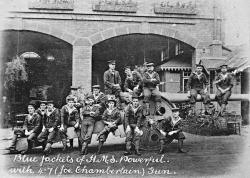
The photograph on the right was recently sent to us by David Lindseth. Written on it are the words "Blue Jackets of H.M.S. Powerful with 4.7 (Joe Chamberlain) Gun". The photograph has been shown to the Curator of Photographs at the Royal Naval Museum who has said:-
"The photograph of the men from HMS Powerful would probably date from the early 1900s, probably
after the Boer War. The men may quite possibly be some of those who saw service in South
Africa. The photo was probably taken in this country, there was a lot of training carried out with
these guns at this period, and we often see images of sailors exercising with 4.7in guns at Whale
Island and other locations".
It seems therefore quite probable that some of the men in the photograph may have seen active service in South Africa and may have been part of the first teams to set up the Naval Field Gun run, but we have no definitive information about this. If anyone reading this has further information about the men in the photo we'd be very interested to hear from you.
Captain Hedworth Lambton
Hedworth Lambton was born in London on 5 July 1856, the third son of George Frederick D'Arcy Lambton, second earl of Durham (1828-1879), and his wife, Lady Beatrix Frances (d. 21 Jan 1871). He was educated at Cheam School and entered the Britannia as a cadet in 1870. He went to sea in December 1871, sailing in the frigate Endymion, of the channel squadron, and later in the flagship Agincourt, under Sir Beauchamp Seymour. From 1876 to March 1879 he served as sub-lieutenant in the flagship Alexandra, in the Mediterranean under Sir Geoffrey Hornby. In 1880, as flag lieutenant to his old chief Sir Beauchamp Seymour he was present at the bombardment of Alexandria (11 July 1882). In July 1886 he returned to the Mediterranean in command of the sloop Dolphin, and in February 1888 he was appointed to command the royal yacht Osborne, a post he held until he was promoted captain in 1889. He was a friend of the Prince of Wales (later Edward VII). From 1890 to 1892 he was flag captain to Charles Hotham in the Warspite on the Pacific station.
From 1894 until 1897 Lambton was naval private secretary to Earl Spencer. In this important office Lambton's judgement on senior officers' appointments was well regardedthough he made few friends amongst the officers with whom he dealt through the lack of consideration which he showed them, although he was far junior to most of them in rank and to all of them in age.
In 1897 Lambton went to the China station in command of the large protected cruiser Powerful-with her sister ship, the Terrible, the largest warship of her day-and on their voyage home in October 1899 he was diverted to Durban, at a critical time early in the South African War. On his way he called at Mauritius, and on his own initiative embarked the 2nd battalion, South Yorkshire regiment. Sir George White, commanding at Ladysmith, had been sending urgent messages for more powerful guns. Captain Percy Scott, in the Terrible, which had arrived at the Cape on its way to replace the Powerful on the China station, improvised field-carriages for naval guns, and with four long 12-pounders and two 4.7 inch guns Lambton landed with a naval brigade and arrived at Ladysmith on 30 October, just in time to prevent its surrender to the besieging Boers. The naval guns, though short of ammunition, countered the Boer artillery throughout the siege, for which the naval brigade gained much press coverage and praise. Lambton was created CB, and on the arrival of the Powerful in England was welcomed with great popular enthusiasm.
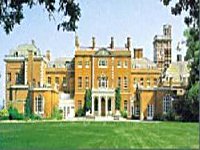 Theobalds Park
Theobalds ParkIn December 1910 he came into a large fortune under the will of Valerie Susie Meux the widow of Sir Henry Brent Meux, third baronet, a brewer, of Theobald's Park, Waltham Cross. During the South African War Lady Meux, hearing of the landing of the naval guns for the defence of Ladysmith, had ordered six naval 12-pounders on travelling carriages to be made at Elswick and sent to Lord Roberts in South Africa. They were known as the Elswick battery. On his return to England later that year, Lambton had called on Lady Meux, described the work of his guns at Ladysmith, and praised her patriotic action in sending similar guns to the front. Touched by this tribute, Lady Meux, after making many wills, decided to make Lambton her heir on the sole condition that he changed his name to Meux. This he did by royal licence in September 1911.
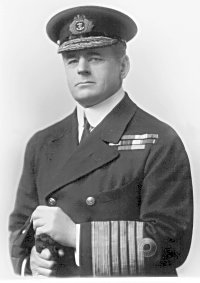 Admiral Sir Hedworth Meux
Admiral Sir Hedworth Meux
Copyright Portsmouth City Museum
Meux was promoted admiral in March 1911, and later that year was considered as the next first sea lord. However he was not selected and Meux remained on half pay until July 1912, when he was appointed commander-in-chief at Portsmouth. He retained this office until February 1916, having been selected for the rank of admiral of the fleet in March 1915.
In 1914 he was persuaded to enter parliament as Unionist MP for Portsmouth. He was popular in the House of Commons and several times spoke vigorously on naval subjects; but he was not really interested in parliamentary work, and retired at the 1918 general election. He devoted much of the remaining part of his life to horse breeding and died on 20 September 1929 at Danebury, an estate which he had bought near Stockbridge, Hampshire. His will was proved at £910,465 gross, with net personalty £734,265. He had no children, and he left his fortune, subject to his widow's interest, to her grandson Sir Ian Hedworth John Little Gilmour, third baronet (b. 1926), later a Conservative MP and cabinet minister.
[Adapted from the Dictionary of National Biography, author V. W. Baddeley, rev. Roger T. Stearn]
Commander Alfred Ethelston
Alfred Ethelston came from Hinton, Shropshire and joined the Royal Navy in 1875. He had already served in Egypt and the Sudan when he was appointed Commander in 1897, at the time the youngest in the Navy. In 1904 his father Robert presented a trophy to the local Shropshire Football League in his son's memory. This trophy, which is still played for every year has Commander Ethelston's miniature medals sunk in the base. It is still presented by a member of the family. In 2001 this was Commander Ethelston's Great Nephew Mike Ethelston.
[Information: Mike Ethelston]
Commander Frederick C. Egerton
Commander Egerton took the Long Course at HMS Excellent in 1896 before joining HMS Powerful. His relatives donated a sum of money towards a a prize at Excellent to be called the "Commander Egerton Prize" in remembrance of him. The prize was to be awarded annually to the Gunnery Lieutenant passing out top of his Long Course. It has been awarded each year since 1902 at the discretion of the Admiralty.
[Information from "Whaley" by Captain John G. Wells]
Alfred Arthur Hickman
A visitor to this page, Sue Randall, saw the photograph of the Bluejackets above and has suggested that the officer at the back may be her great grandfather, Alfred Arthur Hickman who served with the Naval Brigade aboard HMS Powerful during the Seige of Ladysmith. Photographs of Hickman taken several years later do indeed show a physical resemblance to the officer, though we do not as yet have a positive identification.
Sue Randall has provided further information about Hickman who was the third child born to Mark and Harriet Hickman in the village of Ridge in Hertfordshire on 25th June 1871. At about fifteen years of age Alfred Arthur left home and joined the Royal Navy. He trained under sail and wore a straw hat and canvas working trousers. His Grandson Peter remembers being shown an original straw hat and canvas trousers as a child, which must have been kept for a great many years. Alfred Arthur served in the South Atlantic Cruiser Squadron based on the Falkland Islands, which was then a Navy coaling and signal station.
When the Boer War broke out, Alfred Arthur was serving on HMS Powerful, with her sister ship HMS Terrible they made up the Powerful class of large cruisers and were at anchor off Capetown. As the Cape Naval brigade was being prepared, events in Natal meant that the Navy was called on to supply long-range artillery there. Alfred Arthur was one of the 280 Officers and men sent from HMS Powerful who formed part off the Naval Brigade as they were called. Alfred Arthur told that during the time that he was held under siege cats, dogs and horses were eaten and leather and hide were boiled for nourishment. He lost his sight in one eye during his time at Ladysmith but the circumstances are unknown. The relieving Brigade, manhandling their guns over difficult terrain and after being brought into action in many different engagements, eventually reached Ladysmith after 120 days of blockade.
A brass shell case was brought home from Ladysmith by Alfred Arthur as a souvenir of the siege and was engraved: "BOER WAR 1900 - SIEGE OF LADYSMITH - 4.7 SHELL - USED BY THE NAVAL BRIGADE - FROM H.M.S. POWERFUL"
During a long career Alfred Arthur was promoted through the ranks. He progressed from the rank of Petty Officer 2nd Class that he held at Ladysmith to attain the rank of Chief Petty Officer before he retired. During his service he served not only as a trained gunner but also as a Naval diver, for some time he instructed in both skills. During the 1901 Census he was recorded to be a member of the crew of HMS Excellent, a Naval Training establishment based on Whale Island in Portsmouth Harbour.
Henry John Keirl AE
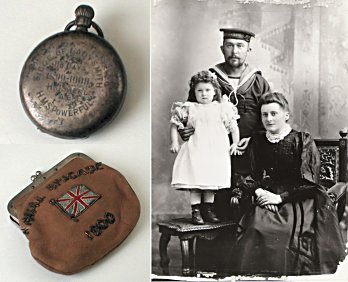 Henry John Keirl, his family, watch and purse
Henry John Keirl, his family, watch and purseIn October 2007 we were contacted by William Serjeant whose grandfather Henry John Keirl served at the seige of Ladysmith as part of the HMS Powerful Naval Brigade. Keirl survived the actions and was present at the dinner in Portsmouth referred to above and was a recipient of the watch and a purse (which is said to have contained the tobacco tin). William Serjeant was kind enough to send us photographs of the watch and purse together with a portrait of Keirl with his family. The watch is engraved with the inscription "SEIGE OF LADYSMITH. 118 DAYS. 1899-1900. H.J.KEIRL A.E. H.M.S. POWERFUL". The Purse is embroidered with the words "NAVAL BRIGADE. 1900" and a Union Flag.
John Wilkinson
In November 2007 we were contacted by Peter Lamb whose wife is probably descended from the Wilkinson family. He kindly sent us photos of the presentation watch and also the Certificate of Warranty that accompanied it. Peter has no other information about John Wilkinson.
Albert Charles Brook
In September 2008 we were contacted by Colin Brook, the Great Grandson of Albert Charles Brook. He kindly sent us photos of the tobacco tin and some further information about his ancestor. He tells us:-
"...his Naval record reveals that he enlisted just a few days after his eighteenth birthday as a 'butcher boy'. He does not appear on the nominal roll of men who went ashore at Durban, to make the journey to Ladysmith.
He stayed with the Royal Navy for his entire career, gaining the long service and good conduct medal, along with the usual WW1 medals. His Queens South Africa medal has unfortunatly been lost to the family for many years.
(He was) born in Queen Camel in Somerset, his home in his latter years was in Portsmouth.
He died on active service on 4th September 1915, serving with H M Coastguard onboard HMS Dalia, the ship was struck by a mine and he was one of only four men killed in the incident, there is quite a touching letter held with the naval record of the incident, from his widow enquiring as to whether he was 'blown to pieces'.
As with so many lost in the first war, he is buried far from home at Rosskeen Parish Church Extensions in Scotland. The CWGC website gives his fathers name as Albert Charles who was living at Garfield Road, Portsmouth. Sadly, Colin's Great Grandfather's name is omitted from the WW1 memorial in Guildhall Square.
Postscript
In July 2012 we were contacted by Paul Dunn who told us he had purchased the QSA with bar Defence of Ladysmith awarded to Albert Charles Brook.
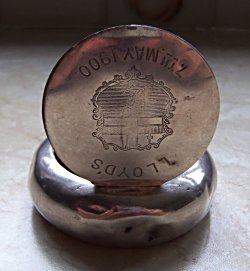
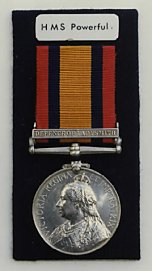
In May 2009 we were contacted by Ian Richards who sent in some images relating to William Keen, including further examples of the certificate, the watch with purse and warranty, and the tobacco tin. In addition however, Ian sent in an illuminated announcement of the Guildhall banquet and a photograph of the inside of the tobacco tin lid.
Ian has no further information about William Keen.
In February 2011 an anonymous correspondent wrote to us with details of the watch awarded to F. Buxton A.B. which he purchased in Australia. He said "It has a stem-wind, stem-set Swiss movement in a Swiss .935 silver, hunting-case measuring approximately 50mm in diameter. Beautiful and still going strong." In a second e-mail he said "I forgot to mention that the movement and face of the watch states: 'S. Smith and Son, 9 Strand, Watchmakers to the Admiralty, London, Swiss Made.' On the seconds dial are the numbers '55/122', possibly a limited edition numbering. I incorrectly said the watch was "stem-set. It is actually stem-wound and "lever-set." The movement is jewelled, and I would say a 15J quality watch". He also sent the images below.
In March 2012 Steve Robertson contacted us with details of another watch, this time the one awarded to Richard White PO1, HMS Powerful. Steve did some research and found that White was born in Nenaegh, Tipperary 13th Jan 1859 and joined the Royal Navy 13th Jan 1877. He was serving on H.M.S Powerful between 8th June 1897 and 8th June 1900 and was finally discharged on 13th Jan 1909. Whilst in South Africa White gave his next-of-kin as Mrs M. Poore, 38 Sidney Road, Gosport. He was listed at that address in the 1901 census. His service record can be downloaded here.

Steve also pointed out a reference to one of the watches being put up for auction in December 2000 by the medal auctioneers Dix Noonan & Webb. The description they provided was:-
"H.M.S. Powerful 'Siege of Ladysmith' Hunter Pocket Watch, silver case, the outer front cover inscribed 'Siege of Ladysmith, 118 Days, 1899-1900, P. McCarthy, L.S., H.M.S. Powerful', the movement inscribed 'S. Smith & Son, 9 Strand, Swiss made, London, Watchmakers to the Admiralty', movement in working order, a little polished, otherwise good condition £300-400". In fact this watch gained a Hammer Price of £720.
Other Crew Members of HMS Powerful who Survived
Douglas Hastings Ramsay - Stoker
Joseph Withecombe - Petty Officer 2nd Class
John George Fleming, Stoker
P. McCarthy, Leading Seaman
See also the plaque in St Ann's Church to HMS Powerful
There are more photographs of HMS Powerful at:- www.battleships-cruisers.co.uk/powerful_class.htm







![HMS Powerful returns home [Photograph taken by William Martin]](images/powerful-home.gif)
![The Crew of HMS Powerful March to the Town Hall [Photograph: Lankester, Tunbridge Wells, copied from the Navy and Army Illustrated]](images/powerful-guildhall.gif)
![The Banquet at the Town Hall [Photograph: A. Debenham, Ryde, copied from the Navy and Army Illustrated]](images/powerful-banquet.gif)





